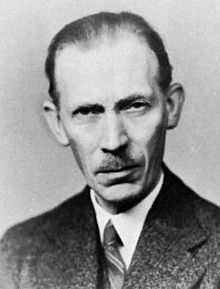Johannes Nicolaus Brønsted
Johannes Nicolaus Brønsted | |
|---|---|
 Portrait of Johannes Brønsted | |
| Born | 22 February 1879 |
| Died | 17 December 1947(aged 68) |
| Nationality | Danish |
| Known for | Brønsted–Lowry acid–base theory Brønsted catalysis equation Specific ion interaction theory |
| Awards | H. C. Ørsted Medal |
| Scientific career | |
| Fields | Physical chemistry |
| Institutions | University of Copenhagen |
Johannes Nicolaus Brønsted(Danish:[joˈhænˀəsne̝koˈlɛːusˈpʁɶnsteð];22 February 1879 – 17 December 1947) was aDanishphysical chemistwho is best known for developing theBrønsted–Lowry acid–base theory;he developed the theory at the same time as (but independently of)Martin Lowry.[1]
Biography
[edit]Brønsted was born inVarde,Denmarkon 22 February 1879. His mother died shortly after his birth, and his father died when Brønsted was 14 years old; he then moved to Copenhagen with his older sister and his stepmother.[2]In 1897, Brønsted began his studies as a chemical engineer at the Polytechnic Institute in Copenhagen.After his first degree, Brønsted changed fields and received hismagister degreeinchemistryin 1902 from theUniversity of Copenhagen.In 1905, he became an assistant at the Chemical Institute and obtained his doctoral degree in 1908. In the same year, Brønsted became a professor ofphysicalandinorganic chemistryat theUniversity of Copenhagen.[3]
In 1929, Brønsted was a visiting professor atYale University.[4]His research gained worldwide recognition, resulting in fourNobel prizenominations, a goldH. C. Ørsted Medaland being appointed as a fellow of theRoyal Societyand a member of theNational Academy of Sciences.[1][5]
Brønsted married Charlotte Warberg, whom he met during his first degree. The couple had four children.[6]InWorld War II,Brønsted's opposition to theNazisled to his election to theDanish parliamentin 1947, but he was too ill to take his seat and died shortly after the election.[1]
Research
[edit]Early in his career, Brønsted studiedchemical thermodynamicsand later studiedelectrolytesolutions and carried out an extensive series of solubility measurements. These measurements led him to establish general laws which were later confirmed when theDebye–Hückel theorywas proposed.[7][3]
Brønsted is best known for his work onreaction kinetics,in particularacid–base reactions.In 1923, he recognized that acid–base reactions involved the transfer of a proton, from theacid(proton donor) to thebase(proton acceptor).[8]Almost simultaneously and independently, the British chemistMartin Lowryarrived at the same conclusion, thus the nameBrønsted–Lowry acid–base theory.[9]Also in 1923,Gilbert N. Lewisproposed anelectronictheory of acid–base reactions, but both theories remain commonly used.[10]
Later in his career, Brønsted kept studying reaction kinetics, with a special focus on reactions taking place innon-aqueous solutions.He also developed some work about the effect of molecular size on the thermodynamical properties of hydrocarbons, polymers and colloids.[7]He also worked with the Nobel prize winnerGeorge de Hevesyonisotope separationby fractional distillation.[11]
References
[edit]- ^abc"Johannes Nicolaus Brønsted".Encyclopædia Britannica.RetrievedMarch 28,2012.
- ^"Biography of Johannes Nicolaus Brönsted (1879-1947)".The Biography.
- ^abBell, R. P.(1950). "The Brönsted memorial lecture".J. Chem. Soc.:409–419.doi:10.1039/JR9500000409.
- ^Oesper, Ralph E.(April 1938). "Johannes Nicolaus Bronsted (1879-)".Journal of Chemical Education.15(4): 151.Bibcode:1938JChEd..15..151..doi:10.1021/ed015p151.
- ^"Nomination Archive - Johannes N Brönsted".NobelPrize.org.1 April 2020.Retrieved27 January2021.
- ^"Johannes Nicolaus Brønsted".Kilder til Dansk Kunsthistorie.Retrieved26 January2021.
- ^abBell, R. P.(February 1948)."Prof. J. N. BrØnsted".Nature.161(4086): 269.Bibcode:1948Natur.161..269B.doi:10.1038/161269a0.
- ^Brönsted, J. N.(1923). "Einige Bemerkungen über den Begriff der Säuren und Basen (Some observations about the concept of acids and bases)".Recueil des Travaux Chimiques des Pays-Bas.42(8): 718–728.doi:10.1002/recl.19230420815.
- ^Lowry, T. M.(19 January 1923)."The uniqueness of hydrogen".Journal of the Society of Chemical Industry.42(3): 43–47.doi:10.1002/jctb.5000420302.
- ^"Johannes Nicolaus Brønsted".Encyclopædia Britannica.RetrievedMarch 28,2012.
- ^Brønsted, J. N.;Hevesy, G.(September 1920)."The Separation of the Isotopes of Mercury".Nature.106(2657): 144.Bibcode:1920Natur.106Q.144B.doi:10.1038/106144c0.
